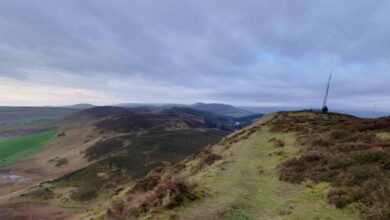Bishop Saltings: The Untamed Beauty of Kent’s Hidden Marshlands

Tucked away in the quiet estuaries of Kent, Bishop Saltings is one of those rare places where nature still rules, undisturbed by modern sprawl. While the name may sound unfamiliar to many, it holds deep geographical and ecological significance in the Medway Estuary — a region celebrated for its salt marshes, birdlife, and wild, unspoiled landscapes. Bishop Saltings stands as a living testimony to the raw beauty and fragile balance of Britain’s coastal ecosystems. This unique salt marsh is more than a patch of tidal ground; it is a thriving natural world shaped by centuries of tides, wind, and wildlife activity.
The Geographic Essence of Bishop Saltings
Located within the Medway Estuary in Kent, Bishop Saltings forms part of a network of tidal mudflats and salt marshes stretching across the southern coast of England. It lies low and flat, constantly shaped by the push and pull of the sea. The term “saltings” refers to land periodically flooded by seawater, where salt-tolerant plants take root and mudflats support countless marine and avian species. Bishop Saltings exemplifies this landscape perfectly — a blend of silt, grass, and brackish water that creates one of the richest habitats in the British Isles.
This is not the kind of place reached by car or casual footpath. Access to Bishop Saltings requires awareness of the tides and the courage to tread where few venture. At high tide, much of it is submerged; at low tide, it reveals an intricate pattern of mud channels and marshland. Its remoteness gives it a timeless character, where the rhythm of the tide is the only measure of life.
Ecological Importance
Bishop Saltings is a treasure chest of biodiversity. Salt marshes like this one act as the lungs of coastal Britain — purifying the air, storing carbon, and serving as nurseries for fish and shellfish. The combination of salt water, silt, and vegetation produces a delicate ecosystem that sustains species at every level of the food chain.
Here, countless birds find refuge and sustenance. Black-headed gulls, redshanks, oystercatchers, and curlews all nest or feed in the area. Each year, thousands of migratory birds descend upon the estuary, turning Bishop Saltings into a seasonal theatre of flight and song. It is one of the few remaining habitats in the UK where such natural spectacles still occur unspoiled by heavy human interference.
The salt-tolerant flora is equally remarkable. Plants such as glasswort, sea aster, and saltmarsh grass thrive in this environment, stabilising the soil and supporting invertebrates. These plants not only form the foundation of the ecosystem but also protect the coastline from erosion by trapping sediments. In times when coastal flooding has become a rising concern, such natural defences are invaluable.
A Haven for Birdwatchers and Naturalists
For birdwatchers, Bishop Saltings is nothing short of paradise. The wide-open skies, the shifting tides, and the abundance of birdlife make it one of Kent’s hidden gems. Observers describe the area as a living painting — constantly changing with the light, tide, and season. During breeding months, the marshes come alive with the calls of gulls and waders nesting in secluded patches of higher ground.
The Medway and Swale estuaries, of which Bishop Saltings is a vital part, are recognised for their international importance under environmental protection schemes. The bird populations here contribute to the broader ecological network that stretches across Europe and beyond. What makes Bishop Saltings particularly special is its isolation; the lack of infrastructure has kept it wild, allowing natural cycles to continue with minimal disturbance.
The Challenges Facing Bishop Saltings
Yet this serenity hides ongoing challenges. Coastal ecosystems across Britain are under pressure from climate change, pollution, and human encroachment. Rising sea levels, stronger storms, and the creeping spread of industrial development threaten to alter these delicate habitats forever. Bishop Saltings, though remote, is not immune to these effects.
Predators such as rats, and disturbances caused by unauthorised visitors, have also been reported. Even well-meaning birdwatchers can sometimes disrupt breeding colonies if they stray too close. Conservationists stress the importance of responsible observation — keeping distance, respecting nesting seasons, and avoiding litter or noise that could harm wildlife.
Another growing concern is the impact of tidal changes caused by upstream engineering. The natural ebb and flow that sustain salt marshes can be disrupted by flood barriers or dredging, which alters sediment movement. Once the silt balance is lost, erosion can accelerate, and the marsh begins to retreat. This is why protecting places like Bishop Saltings is crucial — they act as both a wildlife sanctuary and a buffer against coastal degradation.
Historical Echoes in the Name
The name “Bishop Saltings” itself hints at a fascinating history. In medieval England, lands known as “saltings” were often used for salt production, a valuable trade commodity. The “Bishop” in the title may suggest former ownership or stewardship by the church, which controlled many agricultural and coastal lands across Kent centuries ago. While documentary evidence is limited, such linguistic traces reveal how deeply tied the area’s identity is to both nature and history.
Salt marshes like Bishop Saltings have existed for thousands of years, formed by sediment deposits from ancient rivers and seas. Over time, they became important for local communities — providing grazing land, fish, and salt. Even today, remnants of that past linger in place names, soil layers, and the subtle patterns of the land.
The Role of Salt Marshes in the Modern Era
Beyond their beauty, salt marshes serve vital modern functions. They act as natural flood defences, absorbing excess water during storms. Their vegetation captures and stores large amounts of carbon dioxide, helping to mitigate climate change. Studies show that salt marshes can sequester up to four times more carbon per square metre than tropical rainforests.
Bishop Saltings, though small in comparison to vast estuarine systems elsewhere, contributes to this ecological service. By protecting and restoring such areas, Britain not only preserves its wildlife but also strengthens its resilience against environmental crises. Efforts to restore and conserve salt marshes are gaining traction nationwide, and Bishop Saltings represents exactly the kind of landscape worth safeguarding.
The Quiet Allure of Solitude
What truly defines Bishop Saltings is its quietness. Far from towns, noise, and tourism, it remains one of those rare places where you can hear the wind, the distant cry of gulls, and the faint rush of water. To stand there during low tide is to witness nature in its rawest form — simple, vast, and humbling.
For many visitors, this silence offers more than aesthetic pleasure; it provides mental clarity. Modern life rarely allows moments of stillness, but landscapes like Bishop Saltings remind us of our connection to the earth. They speak of patience, endurance, and harmony between land and sea.
Visiting and Preserving the Area
Visiting Bishop Saltings requires caution and respect. It is not a conventional tourist destination but a living ecosystem. Anyone venturing near must check tide times carefully and avoid walking across the soft, sinking mud. Access by small boat or kayak during suitable conditions is sometimes possible, but always with consideration for the wildlife.
Local authorities and environmental groups encourage visitors to enjoy the view from safe vantage points rather than intruding directly onto the marsh. Responsible exploration ensures that future generations can continue to experience this rare wilderness. As awareness of such natural sites grows, so does the responsibility to protect them.
The Symbolism of Bishop Saltings
Bishop Saltings is more than a geographic name on a map; it is a symbol of the fragile balance between human civilisation and nature. It shows how life thrives even in the harshest conditions — where saltwater meets earth, and tides reshape the land daily. Its survival is a reminder that progress does not always mean construction or technology; sometimes, it means preservation and humility before the natural world.
Every tide that sweeps across Bishop Saltings renews this message. It washes away footprints, resets the landscape, and continues an eternal rhythm that predates human presence. It reminds us that the planet is alive, breathing, and ever-changing — and that we are mere guests upon it.
Conclusion
Bishop Saltings is a rare pocket of wild Britain — a marshland that embodies the soul of Kent’s coastal heritage. It is a sanctuary for birds, a fortress against erosion, and a living laboratory for understanding how land and sea coexist. Though few people have ever walked its muddy paths, its value extends far beyond its boundaries. It teaches the importance of respect for nature, the urgency of conservation, and the beauty that lies in simplicity.
To preserve Bishop Saltings is to honour not just a place, but a principle — that true progress includes protecting the silent, untamed corners of our planet. It is these hidden marshes, these windswept saltings, that remind us of the world’s quiet strength and the endless power of nature to renew itself.



